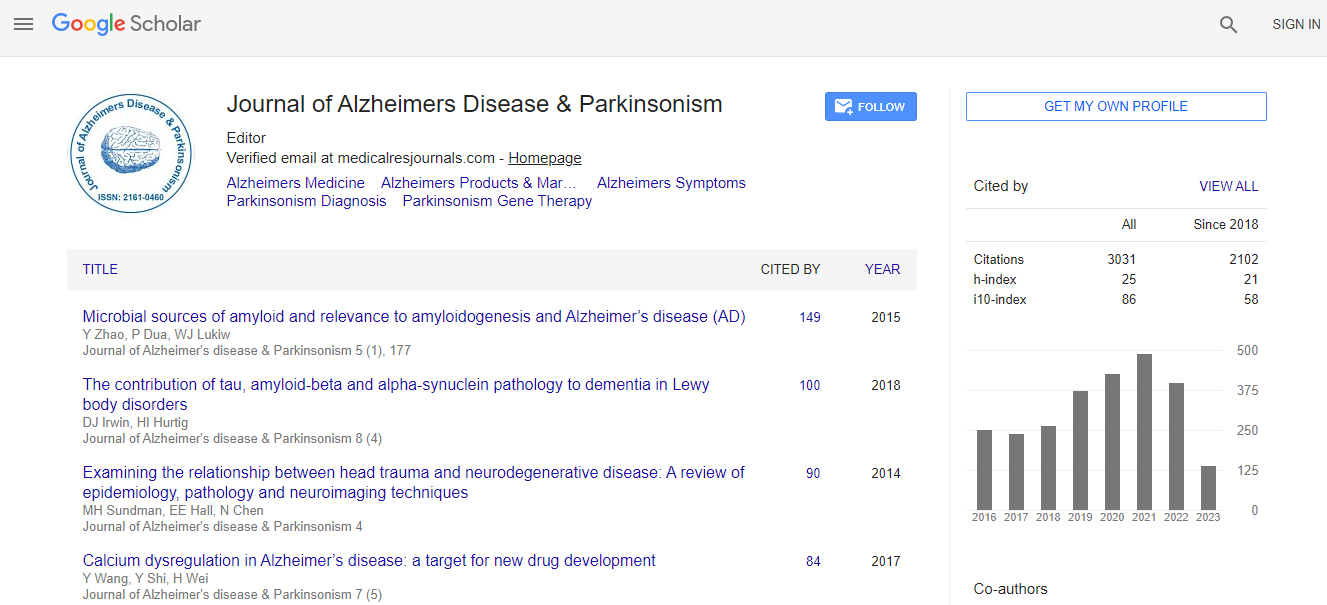Our Group organises 3000+ Global Conferenceseries Events every year across USA, Europe & Asia with support from 1000 more scientific Societies and Publishes 700+ Open Access Journals which contains over 50000 eminent personalities, reputed scientists as editorial board members.
Open Access Journals gaining more Readers and Citations
700 Journals and 15,000,000 Readers Each Journal is getting 25,000+ Readers
Google Scholar citation report
Citations : 4334
Journal of Alzheimers Disease & Parkinsonism received 4334 citations as per Google Scholar report
Journal of Alzheimers Disease & Parkinsonism peer review process verified at publons
Indexed In
- Index Copernicus
- Google Scholar
- Sherpa Romeo
- Open J Gate
- Genamics JournalSeek
- Academic Keys
- JournalTOCs
- China National Knowledge Infrastructure (CNKI)
- Electronic Journals Library
- RefSeek
- Hamdard University
- EBSCO A-Z
- OCLC- WorldCat
- SWB online catalog
- Virtual Library of Biology (vifabio)
- Publons
- Geneva Foundation for Medical Education and Research
- Euro Pub
- ICMJE
Useful Links
Recommended Journals
Related Subjects
Share This Page
Ronald J. Killiany
Biography
Dr. Killiany received his master’s degree in psychology from the University of Hartford and completed doctoral training in psychology at Northeastern University. He completed postdoctoral fellowship training in neuroanatomy, neurobiology, and neuropsychology at the Boston University School of Medicine and joined its faculty in 2001. In addition to his appointments at BUSM, Dr. Killiany currently teaches psychology at Northeastern University and is a Research Associate of Radiology at Brigham and Women’s Hospital, Harvard Medical School and Research Associate of Psychiatry at Massachusetts General Hospital, Harvard Medical School.
Research Interest
Dr. Killiany’s research has been focused on exploring the relationship between brain structure and behavior. To a large extent, the studies have focused on the morphological changes that take place in the brain during aging and disease processes. Initial work began in his graduate work with developmental studies to determine specific structure/function relationships in the memory system of the non-human primate as a model for human development. This theme continued into his postdoctoral studies of normal aging and cerebrovascular disease using non-human primates, where the focus was been on characterizing cognitive changes. In collaboration with investigators at Brigham and Women’s Hospital and Massachusetts General Hospital, his studies began using structural Magnetic Resonance Imaging (MRI) to assess volumetric changes in the brains of healthy elderly and cognitively impaired human subjects. As these collaborative studies evolved, functional techniques such as fMRI (functional magnetic resonance images) SPECT (single photon emission computerized tomography) and PET (Positron Emission Tomography) scanning were included. Iin recent years, his work has shifted focus to include studies aimed at exploring the value of MRI in predicting which subjects will progress to develop cognitive decline of Alzheimer’s disease and which will remain cognitively stable.
Global Speakers in the subject
Global Experts in the subject
Relevant Topics
Peer Reviewed Journals
Make the best use of Scientific Research and information from our 700 + peer reviewed, Open Access Journals

 Spanish
Spanish  Chinese
Chinese  Russian
Russian  German
German  French
French  Japanese
Japanese  Portuguese
Portuguese  Hindi
Hindi 
